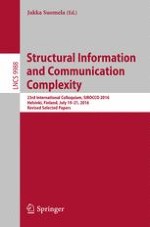Abstract
An oblivious mobile robot is a stateless computational entity located in a spatial universe, capable of moving in that universe. When activated, the robot observes the universe and the location of the other robots, chooses a destination, and moves there. The computation of the destination is made by executing an algorithm, the same for all robots, whose sole input is the current observation. No memory of all these actions is retained after the move. When the spatial universe is a graph, distributed computations by oblivious mobile robots have been intensively studied focusing on the conditions for feasibility of basic problems (e.g., gathering, exploration) in specific classes of graphs under different schedulers. In this paper, we embark on a different, more general, type of investigation.
With their movements from vertices to neighboring vertices, the robots make the system transition from one configuration to another. Thus the execution of an algorithm from a given configuration defines in a natural way the computation of a discrete function by the system. Our research interest is to understand which functions are computed by which systems. In this paper we focus on identifying sets of systems that are universal, in the sense that they can collectively compute all finite functions. We are able to identify several such classes of fully synchronous systems. In particular, among other results, we prove the universality of the set of all graphs with at least one robot, of any set of graphs with at least two robots whose quotient graphs contain arbitrarily long paths, and of any set of graphs with at least three robots and arbitrarily large finite girths. We then focus on the minimum size that a network must have for the robots to be able to compute all functions on a given finite set. We are able to approximate the minimum size of such a network up to a factor that tends to 2 as n goes to infinity.
The main technique we use in our investigation is the simulation between algorithms, which in turn defines domination between systems. If a system dominates another system, then it can compute at least as many functions. The other ingredient is constituted by path and ring networks, of which we give a thorough analysis. Indeed, in terms of implicit function computations, they are revealed to be fundamental topologies with important properties. Understanding these properties enables us to extend our results to larger classes of graphs, via simulation.
